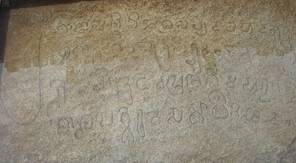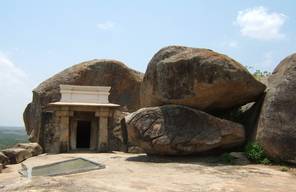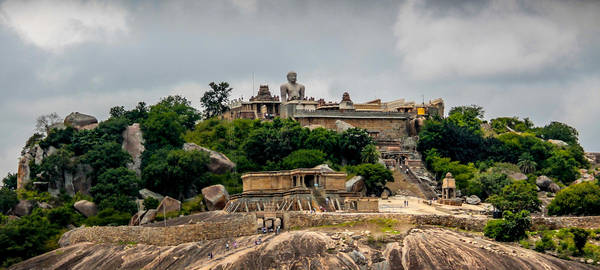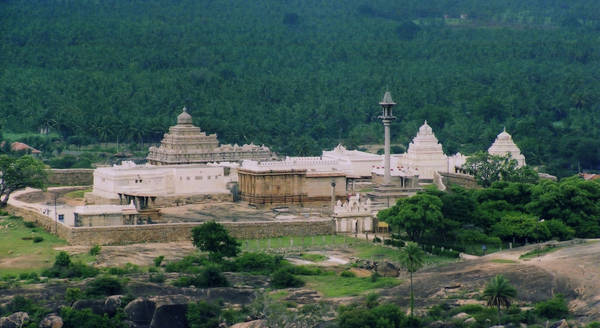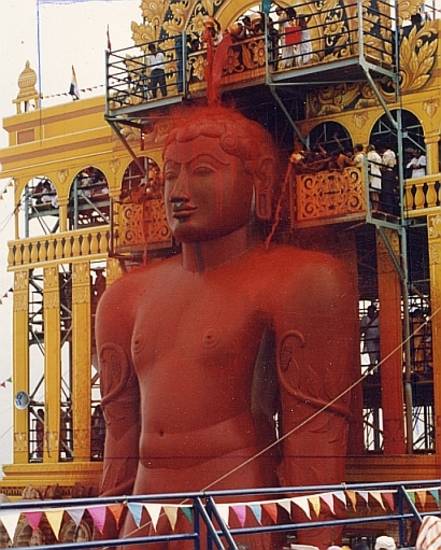Article: Śravaṇa Beḷgoḷa
Located in the Hassan district of Karnataka, the small town of Śravaṇa Beḷagoḷa – frequently transliterated as Shravana Belgola – is one of the most important Jain sacred places, especially for Digambaras. It is closely associated with the early history of Jainism and with Bāhubali, the spiritual hero whose colossal statue has dominated the site since the tenth century. The idol is the focus of celebrations every 12 years in a grand festival that draws thousands of pilgrims and tourists.
Shravana Belgola also commemorates devout Jains who have chosen to fast to death at this holy site and those who have died as warriors. The twin hills and lake of Shravana Belgola help give the site a special atmosphere of peace and serenity, which is remarked on by almost all those who visit.
Main features
The setting of the holy site of Shravana Belgola is striking, with a lake positioned between two hills on a flat plain. The hills and lake form the heart of the small town of Shravana Belgola. The historical name for the lake probably gives the place its name. Both hills are holy sites, with the larger gaining most attention from pilgrims thanks to the huge statue of Bāhubali on its peak.
Since the tenth century the colossus has drawn generations of religious visitors and tourists, many of whom have left written evidence on the landscape. Hundreds of inscriptions can be seen all over the rocks and structures on the hills, some dating back centuries.
Topography
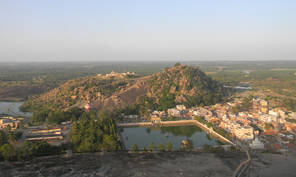
View across Shravana Belgola
Image by Pradam © CC BY-SA 3.0
The ancient site of Shravana Belgola is made up of a lake, two hills and a small town. Both hills are steep and rocky, the lake and town sitting between them.
Found in a very shallow valley, the lake is mentioned in ancient inscriptions as the ‘White Lake’ – Dhavala – or Śveta-sarovara in Sanskrit. Beḷagoḷa – or ‘Belagola’ – is a Kannada term with the same meaning. Śravaṇa – or ‘shravana’ – is another form of the Sanskrit term śramaṇa. It means ‘ascetics‘, especially ‘Jain ascetics‘. Today this lake is known as Kalyani. At some point in the 19th century the lake was given walls on each side and therefore is now square.
The larger of the two hills is known by three names – Vindhya-giri, Indra-giri or Doddabetta. These all mean ‘Large Hill’. It is a great dome of smooth grey granite strewn with mighty boulders and masses of broken rocks. It is 3,347 feet above sea level and 470 feet higher than the surrounding plain. Since the end of the tenth century the enormous image of Bāhubali has stood at the summit. Built by a philanthropist from Bombay in 1884, the flight of 500 steps leads to the top. Everybody has to climb to the top barefoot. As it boasts such an awe-inspiring statue, this hill attracts the lion’s share of attention and there is a tendency to think less about the other one, although it is equally rich.
The smaller hill is on the other side of the village and also has several names, all meaning ‘Small Hill’. Called Candra-giri, Tīrtha-giri, Ṛṣi-giri, Kaḷavappu – from the Sanskrit Kaṭavapra – and Chikkabetta, it rises 175 feet above the plain. History shows that Jains used it as a holy place earlier than the large hill and it boasts several important vestiges of the Jain past. Seeing far fewer visitors than its sister hill, Candra-giri’s atmosphere is very peaceful and it is seen as an appropriate place for meditation and asceticism.
The town of Shravana Belgola nowadays has a population of approximately ten thousand inhabitants. It has several temples, the most prominent of which is the so-called Jain maṭh or maṭha, spelt ‘mutt’ in English. It is ornamented with mural paintings from the 17th and 18th centuries. These depict episodes from the life of Pārśvanātha or Lord Pārśva, the 23rd Jina, and the legend of a Jain character, Nāgakumāra (see Doshi 1981).
For centuries the maṭh has been the residence of a Digambara religious leader – bhaṭṭāraka -– who holds the title of Charukirti. The present bhaṭṭāraka is Karma-yogi Swasti Shri Charukirti Bhattarakaji. Born in 1949, he is the force behind the development of Shravana Belgola as one of the principal Jain pilgrimage sites and general tourist attractions in the last forty years. He supervised the organisation of three of the ritual Anointings of Bāhubali, those in 1981, 1993 and 2006.
Inscriptions
The two hills at Shravana Belgola are covered with antique inscriptions carved directly into the stone of the rocks on the hill, the walls of temples, pillars and so on. Nowadays, some of the important ones, particularly the rocks on the hillside, are protected by glass frames and have been provided with a caption. Modern visitors are not allowed to add their own inscriptions.
There are 573 inscriptions in total, which makes Shravana Belgola a unique site in the number of inscriptions.
|
Place |
Number of inscriptions |
|---|---|
|
Candra-giri |
271 |
|
Vindhya-giri |
172 |
|
Shravana Belgola |
80 |
|
Surrounding villages |
50 |
The inscriptions have been edited and translated in a special volume of the scholarly collection Epigraphia Carnatica. Dating back to a period between 600 and 1820 CE, these inscriptions testify to the presence or visits of mendicants and laity for pilgrimage or other purposes.
Most inscriptions are in the Kannada language and script although some are in the Sanskrit or Prakrit languages using Kannada script. A few of the more recent examples are in Marwari, a language used in Rajasthan, and are records of pilgrims who came from north India.
The inscriptions’ forms and style vary. Some consist of a single laconic sentence while others are detailed accounts of genealogies or religious events, or even poetry. Some describe events from the distant past. It is not always easy to know whether these record legendary traditions or historical facts.
Generally, the subjects of inscriptions relate to:
Religious importance of Shravana Belgola
Shravana Belgola is one of the main religious sites for Jains, particularly those in the Digambara sect. It has been a pilgrimage site for hundreds of years because of its importance in the early history of the Jain faith.
Shravana Belgola has attracted pilgrims for centuries, who initially came to pay homage to two key figures in early Jainism. Ācārya Bhadrabāhu and Emperor Candragupta completed the ritual of fasting to death at Shravana Belgola. Devout Jains have come to the site to follow their example for at least 13 centuries.
The tenth century inaugurated the development of Shravana Belgola as a principal centre of Digambara Jainism. Temples and memorials to Jain warriors began to be built, along with the huge statue of Bāhubali, a figure in Jain Universal History.
Above all, the site of Shravana Belgola is associated with Bāhubali. Though he is not a Jina, Bāhubali achieved enlightenment and, according to some Digambara sources, was the first person to gain liberation in the present era of time. Worshipped primarily by Digambaras, Bāhubali has numerous statues throughout India, the most famous of which is found here.
Bhadrabāhu and Candragupta
The longstanding sanctity of the place to the Jains first comes from its association with the religious teacher Bhadrabāhu and the emperor Candragupta, the founder of the Maurya dynasty. The hill of Candra-giri has several artefacts that are traditionally connected with these important figures of the Jain past.
The historical details are vague but it is believed that a severe drought of 12 years led Bhadrabāhu and Candragupta to migrate from northern India in the 3rd century BCE. They brought a large portion of the mendicant community to southern India. This mythical event is recorded in an inscription of 600 CE on the hill of Candra-giri. According to Digambara traditions, Candragupta renounced his kingship and became a mendicant and both Bhadrabāhu and Candragupta undertook the ritual of fasting to death at Shravana Belgola.
According to tradition, the presence of both men can be traced principally in the following three venerated features of Shravana Belgola:
- Bhadrabāhu’s Cave
- Bhadrabāhu’s footprints
- Candragupta Basadi.
The cavern known as Bhadrabāhu’s Cave is found on Candra-giri and shelters what is considered to be Bhadrabāhu’s footprints – caraṇa. The Candragupta Basadi is a small temple on Candra-giri, built to mark the place where the emperor is supposed to have died. It looks ancient but it is impossible to know when it was built. The temple contains a remarkable screen panel of stone in two parts, with 90 scenes relating to the legends of Bhadrabāhu and Candragupta. The screen is a later addition, probably dating back to the 12th century. One of the scenes depicts the 16 dreams seen by Candragupta, which were interpreted by Bhadrabāhu, revealing the predictions they concealed.
These features are meant to underline the connection with these revered figures but are historically dubious. Bhadrabāhu’s Cave is an example of a phenomenon found in many pilgrimage places as they rise and fall in prominence over the centuries. The claims of religious sites may rarely be able to withstand historical scrutiny but Bhadrabāhu’s Cave ‘in fact […] represents an anachronistic attempt to enhance the prestige of an emerging holy place’ (Dundas 2002: 225).
Fasting to death at Shravana Belgola
The legendary example set by Candragupta and Bhadrabāhu is the basis of the fame of the two hills at Shravana Belgola that lie at the heart of the site. The hills became the destination of those who wanted to carry out the ritual known as fasting to death – sallekhanā.
Several stone pillars, reliefs and temples are memorials – nisidhi – to those who have performed the ceremony. A large number of inscriptions engraved directly on the rocky ground or on pillars, walls and so on record periods of fasting undertaken by ascetics and later also by lay men. Dubbed sanyasa or sanyasana – ‘complete rejection’ – in the inscriptions, these fasts are a way of embracing the experience of the original two fasters.
The oldest memorials date back to a period between the seventh to tenth centuries. An instance is this simple epigraph:
Upasena-guravaḍigaḷ, disciple of Paṭṭini-guravaḍigaḷ of Mālanūr, having observed the vow of sanyasana for one month, ended his life.
Epigraphia Carnatica, Number 28, Candragiri hill
Local courts and warriors
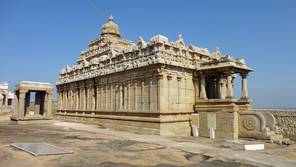
Chamundaraya Basti
Image by HoysalaPhotos © CC BY-SA 3.0
The tenth century marked a new development in Shravana Belgola’s place in Jain sacred geography.
One of the key persons in this change was Cāmuṇḍarāya, a minister serving Rājamalla IV, a king of the Ganga dynasty who ruled Karnataka from 974 to 984 CE. Cāmuṇḍarāya was a follower of Jainism through his spiritual teacher, Nemicandra. This period corresponded to a golden age for the Jains in Karnataka, seeing the foundation of the Shravana Belgola maṭha. It became a centre of economic activity under the leadership of the local religious authority – bhaṭṭāraka – which became the owner of several villages, lands and so on.
Hero stones commemorating those who died in war from the tenth century onwards are also present on Candra-giri.
Statue of Bāhubali
The 17-metre-high statue of Bāhubali that dominates Shravana Belgola was erected at the end of the tenth century. Set at the top of Vindhya-giri, this idol is often referred to as Gommaṭa or Gommaṭeśvara, which are alternate names of Bāhubali, especially in Karnataka.
The statue shows this spiritual hero standing in the meditation posture known as kāyotsarga, with which he is closely associated. Son of the first Jina, Ṛṣabhanātha or Lord Ṛṣabha, Bāhubali is often considered equal to a Jina, though he is not one.
Origins of the statue
The minister and general Cāmuṇḍarāya commissioned the image and the consecration took place during the reign of Rājamalla. The precise date is not known for sure, but cross-referencing information from various inscriptions and literary works suggests that it was around 983 CE. The date of Sunday 13th March 981 is widely accepted, since it meets astrological requirements for ritual installation and matches information in some documents. The year 1981 was therefore proclaimed the millennium anniversary of the official ritual installation– pratiṣṭhā.
It is not known exactly why the idol of Bāhubali was commissioned. Legendary accounts and historical events offer their own explanations for the statue’s construction.
It seems that Bāhubali was very popular among the royal dynasties of the Deccan Plateau in southern India. Some even considered him as their lineage deity – kula-deva. Part of the warrior caste, these dynasties were frequently at war and members of the same family often fought one another. Bāhubali’s defeat of his half-brother Bharata indicates why he could easily have become their hero. The erection of the colossal statue at Shravana Belgola could have been a means of proclaiming this association publicly.
A legendary account also explains why the image was erected there. Cāmuṇḍarāya’s mother is said to have taken a vow not to taste milk until she saw Gommaṭa. Cāmuṇḍarāya and she undertook a pilgrimage to north India together, to visit the statue that Bharata had erected to celebrate his brother Bāhubali’s victory. After seeing this dilapidated image, Cāmuṇḍarāya decided to establish a better idol at Shravana Belgola. Back in southern India, he shot an arrow from Candra-giri. It fell on a large boulder on Vindhya-giri. The general approached the place the arrow had landed and, having perceived a clear image of Gommaṭa, he ordered the sculptors to carve the statue on that spot (Jain 2005: 10).
The colossus
The monolithic nude statue, standing like a sentinel, can be seen from a distance of about 10 kilometres away across the flat plain, but not from the foot of the hill. Its size and weight suggest it was carved from a single rock found on the spot because it is hard to imagine that such an impressive block of granite could have been carried up the steep hill.
The majestic and very sober statue is freestanding in an open courtyard, facing north. The shoulders of the figure are squared and the arms hang straight down the sides with the thumbs turned outwards. The feet rest upon a low pedestal carved to represent an open lotus flower. The face has regular features, short hair styled in spiral ringlets and very long earlobes. Up the legs twine foliage and vines, representing the long period of deep, motionless meditation for which Bāhubali is known.
It is extremely difficult to give exact measurements of the immense statue and reports vary, but the rough statistics are impressive.
|
Body part |
Approximate measurement |
|---|---|
|
Width across the shoulders |
8 metres / 26 feet |
|
Length of toes |
0.83 metres / 2 feet 9 inches |
|
Length of middle finger |
1.13 metres / 5 feet 3 inches |
|
Length of foot |
2.74 metres / 9 feet |
|
Height of the heel |
0.84 metres / 2.75 feet |
|
Span of the waist |
3.05 metres / 10 feet |
This impressive and majestic image, with its unique features, leaves hardly anyone indifferent. An example is that of the Jain Kannada poet Boppaṇṇa, whose work is engraved in a Shravana Belgola inscription dated 1180 (Number 234/336; Sangave 1981: 84). Down the centuries, many foreign travellers have also been struck by this arresting sight.
The spirit of Jain renunciation is fully brought out in the statue. The nudity of the image indicates absolute renunciation while its stiff and erect posture stands for perfect self-control. The benign smile on the face shows inward bliss and sympathy for the suffering world
Sangave
1981, page 83
Temples and holy objects
The two hills and the town at the site house scores of temples built at different periods. These show how various royal dynasties wanted to demonstrate their presence at Shravana Belgola, to be associated with its religious and cultural prominence. The site also has a host of objects considered sacred. Ranging from inscriptions and boulders to pillars and buildings, these display either artistic merit or religious interest. Scholars have not explored these temples and holy artefacts in much detail so it is wise to avoid going beyond basic information in this context.
Vindhya-giri
Of the eight temples found here, four form the focus of pilgrims‘ interest on the hill.
|
Date of completion |
Features |
|
|---|---|---|
|
Chaubis Tirthankara Basti |
1648 |
|
|
Oudegal Basti or Trikut Basti |
|
One of the biggest temples at the site, boasting images of the Jinas Ṛṣabhanātha or Lord Ṛṣabha, Śāntinātha or Lord Śānti and Neminātha or Lord Nemi. |
|
Chennanna Basti |
1673 |
Named after the builder, it has an image of the eighth Jina Candraprabha and several noteworthy pillars. |
|
Siddharth Basti |
|
A small image of Lord Siddha. |
In addition, there are holy artefacts that are not temples on Vindhya-giri. These are also interesting to religious visitors and tourists.
|
Holy object |
Description |
|---|---|
|
Akhand Bagilu |
Carved out of a single boulder of granite, this ‘door without joints’ forms the entrance to the upper enclosure of the statue. |
|
Siddhargundu |
A big slab of granite bearing numerous inscriptions and images of Jain teachers. |
|
Gullikayijji Bagilu |
Named after a devotee, it displays an inscribed image of a sitting woman. |
|
Tyagad Brahmdeva Stambha |
This is a carved pillar showing, among other scenes, Cāmuṇḍarāya and his religious mentor Nemicandra. |
Candra-giri
There are 16 temples on Candra-giri, most of which are generally small in size. The oldest one dates back to the eighth century though most of them were completed in the 12th century.
In addition, there are holy objects on the hill that are significant in either religious or artistic terms. These comprise sculptures and buildings as well as a large granite boulder.
|
Date of completion |
Features |
|
|---|---|---|
|
Chamundaraya Basti |
982 |
Built by Cāmuṇḍarāya, it houses an image of the 22nd Jina Neminātha or Lord Nemi on the ground floor and of the 22nd Jina Pārśvanātha or Lord Pārśva on the upper storey. |
|
Shantinath Basti |
|
It features a statue of the 16th Jina Śāntinātha or Lord Śānti. |
|
Chandragupta Basti |
|
Marking the spot where Candragupta fasted to death, it holds a two-part stone screen depicting stories of Bhadrabāhu and Candragupta. The screen is a later addition, probably of 12th-century origin. |
|
Parshvanath Basti |
|
It houses an idol of Pārśva with seven snakehoods plus a younger, freestanding pillar – māna-stambha – built in 1700. |
|
Kattale Basti |
1118 |
Meaning the ‘Dark Temple’, it was repaired in 1885 and holds an image of the first Jina Ṛṣabhanātha or Lord Ṛṣabha. |
|
Chandraprabhu Bati |
probably 800 |
It houses an image of the eighth Jina Candraprabha-svāmī or Lord Candraprabha. |
|
Shasan Basti |
1137 |
Called the ‘Inscription Temple’, it features a statue of Ṛṣabha and an inscription at the door. |
|
Majjigana Basti |
|
Named after the builder, the temple holds an image of the 14th Jina Anantanātha or Lord Ananta. |
|
Eradukkate Basti |
1118 |
It houses an image of Ṛṣabha. |
|
Savati Gandha Varan Basti |
1123 |
It contains an idol of Śānti. |
|
Terin Basti |
1115 |
It is dedicated to Bāhubali. |
There are other sacred objects on Candra-giri that are of religious and artistic note.
|
Holy object |
Description |
|---|---|
|
Chamundaraya Sila |
A big boulder of granite of this name at the foot of Candra-giri. |
|
Kuge Brahma-deva Stambha |
A lofty pillar at the south entrance of the enclosure with a seated figure of the god Brahma-deva on top. |
|
Mahanavami Mandap |
Two pavilions to the south of Kattale Basti with stone slabs, one of which records the fasting unto death of a Jain monk in 1176. |
|
Bharateshwarji |
A statue of Bharata, Bāhubali’s half-brother, from knees to head. |
|
Iruve Brahmadeva Temple |
Outside the walled area, this temple was built in 950 and houses an image of Brahma-deva. |
Shravana Belgola town
The town of Shravana Belgola holds several temples and religious buildings that attract pilgrims and visitors interested in art and history. Mostly dating from the 12th century, the temples and other buildings shine a light on the religious and political history of the site over the centuries.
|
Temple |
Date of completion |
Features |
|---|---|---|
|
Bhandari Basti |
||
|
Akkan Basti |
1180 |
Dedicated to the 22nd Jina Pārśvanātha or Lord Pārśva. |
|
Siddhant Basti |
1700 |
Its name arose because it used to house the authoritative Digambara scriptures. |
|
Danashale Basti |
The place where the maharajahs gave donations for the upkeep of the shrines and chief statue. |
|
|
Kallamma |
|
A non-Jain temple dedicated to the Hindu goddess Kālī, to which the Jain Maṭha sends rice. |
|
Nagar Jinalaya |
1195 |
Features a standing figure of the first Jina Ṛṣabhanātha or Lord Ṛṣabha. |
|
Mangayi Basti |
1132 |
Shelters an image of the 16th Jina Śāntinātha or Lord Śānti. |
|
Jain Maṭha |
10th century |
Headed by the bhaṭṭāraka, it owns several villages and lands and is a centre of economic activity. |
Later history of Shravana Belgola
A survey of the temples and sacred objects found on the site shows that the main architectural activity was completed before 1300. Yet the following centuries saw some additions and enlargements, demonstrating how royal dynasties continued to patronise Jainism in Shravana Belgola. This was the case not just with the Jain dynasty of the Hoysalas (1006–1345), but also with the Vijayanagara kings and the Mysore rulers from the 17th century onwards. Although non-Jain, they were tolerant of Jainism, at least to some extent. They showed their protection through grants of lands or money to repair the temples and by encouraging Jain worship.
Even so, religious life in the site was less vibrant than in earlier periods because after the 12th century the influence of the local Jain communities diminished. This was felt in several areas, such as:
- the presence of Digambara mendicant communities dropped
- the head-anointing ceremony was not celebrated regularly because of lack of funds or because it was forbidden by some Muslim rulers
- economic and political circumstances were not favourable to the public expression of Digambara Jainism.
Nowadays, Shravana Belgola is a peaceful, holy place with about 10,000 inhabitants, but every dozen years the population increases temporarily by thousands during the renowned ceremony of anointing the statue of Bāhubali. This huge event is managed by the state government of Karnataka with the active support of the local bhaṭṭāraka and of Digambara communities all over India.
Reading
- A Journey from Madras through the countries of Mysore, Canara, and Malabar: for the express purpose of investigating the state of agriculture, arts and commerce; the religion, manners, and customs; the history natural and civil, and antiquities
Francis Buchanan - T. Cadell and W. Davies; London, UK; 1807
- ‘The Temples and Monuments of Shravana Belgola’
Robert J. Del Bonta - Homage to Shravana Belgola
edited by Saryu Doshi
Marg Publications; Bombay, Maharashtra, India; 1981
- ‘The Art Treasures of Shravana Belgola’
Saryu Doshi - Homage to Shravana Belgola
edited by Saryu Doshi
Marg Publications; Bombay, Maharashtra, India; 1981
- The Jains
Paul Dundas - Library of Religious Beliefs and Practices series; series editor John Hinnels and Ninian Smart; volume 14
Routledge Curzon Press; London, UK; 2002
- Bahubali of Jainbadri (Shravanabelagola) and Other Jain Shrines of Deccan
Surendranath Shripalji Jain and Sarojini Surendranath Jain - S.D.J.M.I. Managing Committee; Shravanabelagola, Karnataka, India; 2005
- Opulent Candragiri
Hampa Nagarajaiah - S.D.J.M.I. Managing Committee; Shravanabelgola, Karnataka, India; 2001
- Inscriptions at Sravana Belgola
Benjamin Lewis Rice - Epigraphia Carnatica series; volume 2
Institute of Kannada Studies, University of Mysore; Mysore, Karnataka, India; 1973
- World Renowned Jain Pilgrimages: Reverence and Art
Mahopadhyaya L. Sagar - Prakrit Bharati Academy; Jaipur, Rajasthan, India; 2000
- The Sacred Shravanabelagola: A Socio-Religious Study
Vilas A. Sangave - Bhāratīya Jñānapīṭh Publication; New Delhi, India; 1981
- Śravaṇa Beḷgoḷa: an illustrated study
Shadakshari Settar - Rūvāri; Dharwad, Karnataka, India; 1981
- Inviting Death: Historical Experiments on Sepulchral Hill
Shadakshari Settar - Institute of Indian Art History, Karnatak University; Dharwad, Karnataka, India; 1986
- Pursuing Death: Philosophy and Practice of Voluntary Termination of Life
Shadakshari Settar - Institute of Indian Art History, Karnatak University; Dharwad, Karnataka, India; 1990
Links
- Seven Wonders of India – Shravanabelagola
-
The Digambara pilgrimage site of Shravana Belagola in Karnataka is the subject of this NDTV video on YouTube. The presenter gives a brief history of the site and the story of Bāhubali, whose huge statue is the focus of worship. Some pilgrims in ill health are carried in sedan chairs up and down the steep hill, atop which stands the Bāhubali colossus. Inscriptions protected by heavy sheets of glass are shown. Pilgrims performing worship rituals are filmed, including the sacred bath or ‘head-anointing ceremony’ – mastakābhiṣeka – of a small metal image of Gommaṭeśvara or Bāhubali.
The New Delhi Television show Seven Wonders of India asked viewers to vote for their favourite seven sites in the country. It was part of a publicity campaign organised by the Ministry of Tourism in 2008 to 2009. The show's presenters visited many sites considered potential winners.
- Introduction to Shravana Belgola
-
This audio slideshow on YouTube introduces the pilgrimage centre of Shravana Belgola in Karnataka. Sacred to the Digambara sect in particular, Shravana Belgola is dedicated to Bāhubali, also called Gommaṭeśvara or ‘Lord of Gommaṭa’. The site is found on the twin hills of Vindhya-giri and Candra-giri, with a large reservoir and the town between them. The centre of the site is the 18-metre-tall statue of Bāhubali on Vindhya-giri. This slideshow was uploaded by Boltell in 2010.
- Pilgrimage site of Shravana Belgola
-
This YouTube video shows the Digambara pilgrimage site of Shravana Belgola in Karnataka. Centred on the 18-metre-tall Bāhubali statue at the top of Vindhya-giri, the site also has many temples and holy spots. A small metal image of Gommaṭeśvara or Bāhubali sits at the feet of the colossus, which is flanked by two female figures. The video was uploaded in 2010 by Indiavideodotorg.
- Shravana Belgola description
-
Description of the site of Shravana Belgola and the Mahā-mastakābhiṣeka – ‘Great head-anointing ceremony’ – of the Gommaṭeśvara or Bāhubali statue there. Background material on Jain holy places and Gommaṭeśvara is also given on this page on the Sacred Sites website.
Most of the photographs of the 2006 ‘Great head-anointing ceremony’ are taken from the BBC slideshow by Karoki Lewis.
- Francis Buchanan biography
-
This Wikipedia entry profiles Francis Buchanan (1762–1829), who carried out extensive surveys of southern and north-eastern India during the British East India company's expansion into India.
- Worship at Shravana Belgola
-
This short 2009 video films a worship ceremony – pūja – at the pilgrimage site of Shravana Belgola in Karnataka. The temple attendants perform the daily ritual bath – mastakābhiṣeka – on the small metal idol at the bottom of the 18-metre-high statue of Bāhubali, also called Gommaṭeśvara or ‘Lord of Gommaṭa. They trickle water on to the feet of the stone colossus and offer it to worshippers because the water is believed to have special properties after it has been used in the ceremony. The grand version of the rite – Mahā-mastakābhiṣeka or ‘Great head-anointing ceremony’ – is one of the most spectacular Jain festivals and takes place every 12 years, drawing thousands of pilgrims and sightseers. ifredpr uploaded this video to YouTube in 2011.
- Shravana Belgola summary
-
Background information about the pilgrimage site of Shravana Belagola in Karnataka. Holy to the sect of the Digambaras in particular, Shravana Belagola is focused on the towering statue of Bāhubal, frequently called Gommaṭeśvara or ‘Lord of Gommaṭa’. The 18-metre-tall idol is at the top of the hill of Vindhya-giri so visitors must climb 500 steep steps barefoot to reach it. The Archaeological Haecceities blog provides this information about the stone colossus.
http://haecceities.wordpress.com/2009/08/27/shravanabelagola-almost-a-seventh-wonder-of-the-world/
- Colin Mackenzie biography
-
This Wikipedia article on Colin Mackenzie (1753–1821) summarises his career. As the first Surveyor General of India under early British colonial rule, he supervised detailed investigations into Indian architecture, especially in southern India.
- +
- aAbhavya
- aAbhinandana
- aAbhiṣeka
- aĀcāra
- aĀcārāṅga-sūtra
- aĀcārya
- aAchalbhrata
- aAḍhāī-dvīpa
- aAdharma
- aAdho-loka
- aAdhyayana
- aAdvaita Vedānta
- aĀgama
- aAghātīya
- aAghātīya-karman
- aAgnibhuti
- aAgra
- aĀhāra
- aAhiṃsā
- aAhimsa Day
- aAjita
- aAjīva
- aAkampit
- aĀkāśa
- aAkbar the Great
- aAkṣaya-tṛtīyā
- aAlauddin Khalji
- aAlbert Einstein
- aAllah
- aAlms
- aĀlocanā
- aAloka-ākāśa
- aAmāri
- aAmbikā or Kūṣmāṇḍinī
- aAnagāra
- aAnanta
- aAnarthadaṇḍa
- aAnaśana
- aAnekānta-vāda
- aAṅga
- aAniconism
- aAnojjā
- aAntarāla
- aAntarāya-karma
- aAṇu
- aAṇu-vrata
- aAnukampā
- aAnuprekṣā
- aAnusvāra
- aApabhraṃśa
- aAparigraha
- aAra
- aĀrambha
- aĀrambhaja
- aĀratī
- aArdhamāgadhī Prākrit
- aArhaṃ
- aArhat
- aArśana-āvaraṇīya-karma
- aĀrta-dhyāna
- aĀryikā
- aĀryikā Jñānamati
- aĀśātanā
- aĀścarya
- aAscetic
- aAsceticism
- aAshram
- aAspiration
- aĀsrava
- aAṣṭa-maṅgala
- aAṣṭāpada
- aAstikāya
- aAstrolabe
- aAsura
- aAtheism
- aAticāra
- aAtiśayakṣetra
- aAtithisaṃvibhāgavrata
- aĀtma-vāda
- aĀtman
- aAuṃ
- aAurangzeb
- aAuspicious
- aAusterity
- aAvadhāna
- aAvadhi-jñāna
- aĀvaraṇī-yakarman
- aAvasarpiṇī
- aAvatāra
- aAvidyā
- aAxiom
- aĀyāga-paṭa
- aĀyambil
- aĀyu-karma
- aĀyurveda
- bBabur
- bBāhubali
- bBaladeva
- bBālāvabodha
- bBandha
- bBasadi
- bBazaar
- bBhadrankarvijay
- bBhagavant
- bBhaktāmara-stotra
- bBhakti
- bBhale
- bBharata
- bBhāṣā
- bBhāṣya
- bBhaṭṭāraka
- bBhāva
- bBhāva-pūjā
- bBhāvanā
- bBhavana-vāsin
- bBhavya
- bBhavyatva
- bBhaya
- bBhoga-bhūmi
- bBhogopabhoga
- bBodhi
- bBollywood
- bBrahmā
- bBrahma-deva
- bBrahmacārī
- bBrāhmaṇa
- bBraj Bhāṣā
- bBright fortnight
- bBritish Raj
- bBuddha
- bBuddhi-sagar
- bBuddhism
- bBuddhist
- cCaitya
- cCaityavāsin
- cCakravartin
- cCakreśvarī
- cCāmara
- cCandanā
- cCandragupta
- cCandraprabha
- cCanon
- cCāritra
- cCāritramohanīya-karman
- cCarũrī
- cCaste
- cCaturvidha-saṅgha
- cCaturviṃśati-stava
- cCāturyāma
- cCE
- cCelibacy
- cCha
- cChadmastha
- cChastity
- cCheda-sūtra
- cChristian
- cChristianity
- cClergy
- cCloning
- cColophon
- cCommentary
- cConch
- cConfession
- cCongregation
- cConsecration
- cCosmology
- cCremation
- cCrore
- cCult
- cCūrṇi
- dDādā-guru
- dDalit
- dDāna
- dDaṇḍa
- dDark fortnight
- dDarśana
- dDarśanamohanī-yakarman
- dDaśa-lakṣaṇa-parvan
- dDeity
- dDelhi Sultanate
- dDerāsar
- dDeśāvakāśika-vrata
- dDetachment
- dDevanāgarī
- dDevānandā
- dDevarddhi-gani
- dDevotee
- dDhamal
- dDhanuṣ
- dDhāra
- dDharma
- dDharma-dhyāna
- dDharma-sāgara
- dDharmastikaya
- dDhātakīkhaṇḍa
- dDholak
- dDhyāna
- dDiaspora
- dDig-vrata
- dDigambara
- dDīkṣā
- dDisciple
- dDīvālī
- dDivya-dhvani
- dDNA
- dDoctrine
- dDogma
- dDonor
- dDoṣa
- dDravya
- dDravya-pūjā
- dDrone
- dDuṣamā
- dDuṣamā-duṣamā
- dDuṣamā-suṣamā
- dDveṣa
- dDvīpa
- eEast India Company
- eEightfold Path
- eEkānta-vāda
- eEkendriya
- eElder
- eElders
- eEschatology
- eEtc up to
- fFarmān
- fFast
- fFatehpur Sikri
- fFestival
- fFestschrift
- fFiruz Shah
- fFly-Whisks
- fFolio
- fFour Noble Truths
- gGaccha
- gGaṇa
- gGaṇadhara
- gGanadharavada
- gGaṇeśa
- gGaṇin
- gGarba
- gGarbha
- gGarbha-gṛha
- gGaruḍa
- gGati
- gGene
- gGenomics
- gGhātī-yakarman
- gGhātīya
- gGhaznavid
- gGhiyasuddin Tughlaq
- gGhurid
- gGloss
- gGotra-karma
- gGujarāt
- gGujarati
- gGuṇa
- gGuṇa-sthāna
- gGuṇa-vrata
- gGupti
- gGuru
- gGuruṇī
- hHagiography
- hHajj
- hHaṃsa
- hHaribhadra
- hHariṇaigameṣin
- hHasta
- hHeresy
- hHiṃsā
- hHindi
- hHindu
- hHinduism
- hHīravijaya
- hHoroscope
- hHrīṃ
- hHumayun
- hHymn
- iIconoclasm
- iIconography
- iIdol
- iIndian Independence
- iIndology
- iIndra
- iIndrabhūti Gautama
- iIndriya
- iInitiation
- iIntercession
- iInvocation
- iIQ
- iIslam
- iIslamicate
- iIṣṭadevatā
- iĪśvara
- jJagat
- jJahangir
- jJain
- jJaina Devanāgarī
- jJaina Śaurasenī
- jJaina-dharma
- jJainaśāsana
- jJainness
- jJaisalmer
- jJamāli
- jJambū-dvīpa
- jJames Burgess
- jJanma
- jJanma-kalyāṇa
- jJarā
- jJāti
- jJina
- jJina-āgama
- jJina-bhavana
- jJina-bimba
- jJina-mātā
- jJinacandra-sūri
- jJinadatta
- jJinaprabha
- jJīva
- jJñāna
- jJñāna-āvaraṇīya-karma
- jJñāna-āvarṇiya
- jJñānsundar
- jJyotiṣka
- kKāla
- kKālakācārya-kathā
- kKālidāsa
- kKalpa-sūtra
- kKalpa-vṛkṣa
- kKalyāṇaka
- kKalyanvijay
- kKamaṇḍalu
- kKamaṭha
- kKarma
- kKarma-bhūmi
- kKarma-grantha
- kKarma-prakṛti
- kKarma-vāda
- kKarmon
- kKarnataka
- kKaṣāya
- kKathā
- kKāvya
- kKāya
- kKāyotsarga
- kKeśa-loca
- kKetu
- kKevala-jñāna
- kKevalin
- kKhalji
- kKharatara-gaccha
- kKnowledge
- kKriyā
- kKriyā-vāda
- kKṛṣṇa
- kKṣamā-śramaṇa
- kKṣapakaśreṇi
- kKṣatriya
- kKṣullaka
- kKulakara
- kKundakunda
- kKunthu
- lLabdhi
- lLaity
- lLakh
- lLāñchana
- lLands of Action
- lLaukāntika
- lLavaṇa-samudra
- lLeśyā
- lLiṅga
- lLinguistics
- lLoka
- lLoka-ākāśa
- lLoka-puruṣa
- lLoka-vāda
- lLotus
- lLotus lake
- mMadhya-loka
- mMahā-videha
- mMahā-vrata
- mMahābhārata
- mMahāmastakābhiṣeka
- mMāhārāṣṭra
- mMāhārāṣṭrī Prākrit
- mMahattarā Yākinī
- mMahāvīr Jayantī
- mMahāvīra
- mMakāra
- mMakkhali Gośāla
- mMalli
- mMāna-stambha
- mManaḥ-paryāya-jñāna
- mMaṇḍala
- mMaṇḍapa
- mMandit
- mMaṅgala
- mMantra
- mMantras
- mManuṣya-loka
- mMarāṭhī
- mMārgaṇā
- mMartyr
- mMarudevī
- mMaṭha
- mMati-jñāna
- mMauryaputra
- mMecca
- mMendicant lineage
- mMetarya
- mMiracle
- mMithyādṛṣṭi
- mMohandas Gandhi
- mMohanīya-karma
- mMokṣa
- mMonastic order
- mMonasticism
- mMonk
- mMonotheism
- mMosque
- mMount Meru
- mMount Sammeta
- mMṛgāvatī
- mMughal
- mMuhammad
- mMuhammad bin Tughlaq
- mMuhpattī
- mMūla-sūtra
- mMūlaguṇa
- mMumbaī
- mMuni
- mMunisuvrata
- mMurad Bakhsh
- mMūrti-pūjaka
- mMuslim
- mMysticism
- nNābhi
- nNāga-kal
- nNāgapurīya Tapā-gaccha
- nNāgarī
- nNāma-karma
- nNamaskāra-mantra
- nNami
- nNandīśvara-dvīpa
- nNandivardhana
- nNandyāvarta
- nNāraka
- nNāraki
- nNasalisation
- nNātha
- nNavrātrī
- nNaya-vāda
- nNemi
- nNidāna
- nniggaṃthāṇa vā 2
- nniggaṃtho vā 2
- nNigoda
- nNihnava
- nNikṣepa
- nNirgrantha
- nNirjarā
- nNirvāṇa
- nNiryukti
- nNiṣidhi
- nNitya
- nNiyati
- nNo-kaṣāya
- nNudity
- nNun
- oOcean of milk
- oOmniscience
- oOrdination
- ppa°
- pPadmaprabha
- pPadmāsana
- pPadmāvatī
- pPādukā
- pPalanquin
- pPalette
- pPañca-muṣṭi
- pPāṇḍava
- pPaṇḍit
- pPandit Dalsukh D. Malvania
- pPandit Sukhlalji
- pPāṇipātra
- pPāpa
- pParamātman
- pParameṣṭhin
- pPāraṇā
- pParigraha
- pPariṇāma
- pParīṣaha
- pParokṣa
- pPārśva
- pPārśvanātha
- pParyāya
- pParyuṣaṇ
- pPaṭa
- pPatan
- pPātra
- pPenance
- pPersian
- pPhala
- pPhilology
- pPicchikā
- pPilgrimage
- pPīr
- pPolymath
- pPoṣadha
- pPossession
- pPothī
- pPrabhas
- pPradakṣiṇā
- pPradeśa
- pPrākāra
- pPrakīrṇaka-sūtra
- pPrākrit
- pPramāda
- pPramukhā
- pPrati-vāsudeva
- pPratikramaṇa
- pPratimā
- pPratiṣṭhā
- pPratyākhyāna
- pPratyakṣa
- pPravacana
- pPrāyaścitta
- pPrayer
- pPre-modern
- pPreach
- pPredestination
- pProtestant
- pProvenance
- pPudgala
- pPūjā
- pPujārī
- pPukharavara-dvīpa
- pPuṇya
- pPūrva
- pPuṣkara-dvīpa
- pPuṣpadanta
- pPyre
- qQur’an
- rRāga
- rRāhu
- rRainy season
- rRajasthan
- rRajasthani
- rRājimatī
- rRajoharaṇa
- rRajput
- rRāma
- rRāmāyaṇa
- rRangoli
- rRās-garbā
- rRasa
- rRathanemi
- rRatna-traya
- rRātri-bhojana
- rRaudra-dhyāna
- rRecto
- rRelic
- rRenunciation
- rRetroflex
- rRevatī
- %Ṛg-veda
- rRite
- rRosary
- %Ṛṣabha
- %Ṛṣabhanātha
- rRupee
- sSaciyā Mātā
- sSādhu
- sSādhvī
- sSāgāra
- sSaint
- sŚaivaism
- sŚaka-saṃvat
- sSallekhanā
- sŚalya
- sSamacatuṣṭha
- sSamādhimaraṇa
- sSamaṇi
- sSāmarambha
- sSamavasaraṇa
- sSāmāyika
- sSaṃbhava
- sSamiti
- sSaṃjñā
- sSaṃkalpaja
- sSaṃsāra
- sSamudghāta
- sSaṃvara
- sSaṃvega
- sSamyak-cāritra
- sSamyak-darśana
- sSamyak-jñāna
- sSamyaktva
- sSaṃyama
- sSanctuary
- sSandalwood
- sSaṇgha
- sSanskrit
- sSant
- sŚānti
- sSapta-bhaṅgi-naya
- sSārambha
- sSarasvatī
- sSarvajña
- sSāsan-devi
- sŚāsana-devatā
- sŚāstra
- %Ṣaṭ-jīvanikāya
- sSatī
- sSatīmātā
- sSatya
- sSchism
- sScribe
- sScripture
- sSect
- sSecularism
- sŚenāī
- sSermon
- sŚeṣavatī
- sSevā
- sSeven fields of donation
- sShah Jahan
- sShantidas Jhaveri
- sShrine
- sSiddha
- sSiddha-śilā
- sSiddhacakra or Navadevatā
- sSiddhānta
- sSiddhārtha
- sSiddhi
- sSikh
- sSikhism
- sŚikṣā-vrata
- sŚīla
- sSin
- sSindh
- sŚītala
- sŚiva
- sSkandha
- sSomanatha
- sŚraddhā
- sŚramaṇa
- sŚrāvaka
- sŚrāvakācāra
- sŚrāvikā
- sŚreyāṃsa
- sŚrī
- sŚrīvatsa
- sŚruta-jñāna
- sŚruta-pañcamī
- sSthānaka-vāsin
- sSthāpanācārya
- sSthāvara
- sSthavira
- sSthiti
- sStrīmukti
- sStūpa
- sSubcontinent
- sSudarshana
- sŚuddhi
- sSudharma
- sŚūdra
- sSufism
- sSukha
- sŚukla-dhyāna
- sSulasā
- sSultan
- sSumati
- sSundarśrī
- sSupārśva
- sSūri
- sSuṣamā
- sSuṣamā-duṣamā
- sSuṣamā-suṣamā
- sSūtra
- sSuyam me ausam! Tenam bhagavaya evamakkhayam
- sSvādhyāya
- sSvāhā
- sSvastika
- sŚvetāmbara
- sŚvetāmbara Terāpanthin
- sŚvetāmbaras
- sSwan
- sSyād-vāda
- tTabla
- tTantra
- tTapā-gaccha
- tTapas
- tTāraṇ Svāmī Panth
- tTattva
- tTattvārtha-sūtra
- tTemple
- tTemple-city
- tThe Enlightenment
- tTheology
- tThree worlds
- %Ṭīkā
- tTilaka
- tTīrtha
- tTīrthaṃkaranāma-karman
- tTīrthankara
- tTransliteration
- tTrasa
- tTrasa-nāḍī
- tTriśalā
- tTriṣaṣṭi-śalākā-puruṣa-caritra
- tTti bemi
- tTughlaq
- tTunk
- uUdumbara
- uUniversal History
- uUpādhyāya
- uUpāṅga
- uUpaniṣads
- uUpāsaka
- uUpasarga
- uUpāśraya
- uŪrdhva-loka
- uUtsarpiṇī
- uUttarādhyayana-sūtra
- vVāhana
- vVaimānika
- vVairāgya
- vVaiṣṇava
- vVaiśramaṇa
- vVaiśya
- vValabhī
- vVanaspatikāya
- vVandana
- vVaṇik
- vVarṇa
- vVāsudeva
- vVāsupūjya
- vVayubhūti
- vVeda
- vVedanīya-karma
- vVegetarianism
- vVehicle
- vVernacular
- vVerso
- vVidyā
- vVidyā-devī
- vVihāra
- vVijñapti-patra
- vVikrama-saṃvat
- vVikṛti
- vVimala
- vVinaya
- vVipāka
- vVirji Vora
- vVirodhaja
- vVīrya
- vVisarga
- vViṣṇu
- vVītarāga
- vVizier
- vVotive
- vVow
- vVrata
- vVS
- vVyakta
- vVyantara
- vVyasana
- yYakṣa
- yYakṣī
- yYantra
- yYaśoda
- yYaśovijaya
- yYati
- yYātrā
- yYoga
- yYoginī
- yYojana


